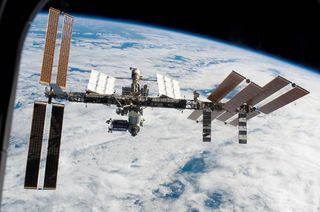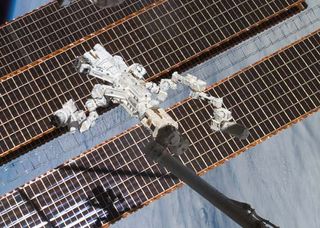Building the International Space Station (Photos)
She's a Beauty

Sunlight glints off the International Space Station with the blue limb of Earth providing a dramatic backdrop in this photo taken by an astronaut on the shuttle Endeavour just before it docked after midnight on Feb. 10, 2010 during the STS-130 mission.
So Lonely

The Russian-built Zarya Control Module was the first piece of the International Space Station (ISS) to take flight in 1998. Here it sits alone in space waiting for additional components and eventual human habitation. The module provides battery power, fuel storage and rendezvous and docking capability for Soyuz and Progress space vehicles.
It Takes Two to Tango

The Unity node (in payload bay at bottom) is connected to the International Space Station's (ISS) Russian-built Zarya Control Module (top) during the STS-88 flight aboard NASA's Endeavour space shuttle in December 1998 and was the second major piece to join the orbital outpost.
From Russia With Love

The Russian-built Zvezda Service Module (at top with spacecraft attached) was launched atop a Russian Proton rocket from Baikonur Cosmodrome, Kazakhstan, on July 12, 2000. The Zvezda provides living quarters and performs some life support system functions for the International Space Station.
All Trussed Up

Launched aboard Space Shuttle Discovery on Oct. 11, 2000, the STS-92 astronauts installed the Z1-Truss at the International Space Station (ISS). Inside the Z1 are four Control Moment Gyroscopes (CMGs) that provide the International Space Station's attitude control. A third pressurized mating adapter was installed on the Unity Node, providing an additional Shuttle docking port. A Ku-band antenna provides television capability.
Get Your Wings

The space shuttle Endeavour launched toward the International Space Station (ISS) on Nov. 30, 2000, where astronauts installed the P6 truss and the platform's wing-like solar arrays during NASA's STS-97 orbiter mission.
Rip It Up

A close-up of the large tear and a smaller rip (to right of larger one) on the one of two Port 6 solar wings on the International Space Station.
Get the Space.com Newsletter
Breaking space news, the latest updates on rocket launches, skywatching events and more!
Harmony, Italian-Style

The Italian-built Harmony connecting node and its PMA-2 shuttle docking port hang off the end of the International Space Station's robotic arm during a Nov. 14, 2007 move by the Expedition 16 crew
Hope of a Nation

Backdropped by Earth's horizon and the blackness of space, the International Space Station is seen from space shuttle Endeavour as the two spacecraft begin their relative separation on March 24, 2008 during NASA's STS-123 mission. Japan's new Kibo ("hope" in Japanese) storage module appears as the squat cylinder atop the central module in this view.
Go, Robot, Go!

Dextre, also known as the Special Purpose Dextrous Manipulator (SPDM), is seen in the grasp of the International Space Station's robotic arm while Space Shuttle Endeavour is docked with the station.
Port of Entry

Russian cosmonaut Oleg Kotov (in red striped spacesuit) works on the International Space Station's new Poisk module to activate its docking port systems in a spacewalk on Jan. 14, 2010.
Join our Space Forums to keep talking space on the latest missions, night sky and more! And if you have a news tip, correction or comment, let us know at: community@space.com.

Space.com is the premier source of space exploration, innovation and astronomy news, chronicling (and celebrating) humanity's ongoing expansion across the final frontier. Originally founded in 1999, Space.com is, and always has been, the passion of writers and editors who are space fans and also trained journalists. Our current news team consists of Editor-in-Chief Tariq Malik; Editor Hanneke Weitering, Senior Space Writer Mike Wall; Senior Writer Meghan Bartels; Senior Writer Chelsea Gohd, Senior Writer Tereza Pultarova and Staff Writer Alexander Cox, focusing on e-commerce. Senior Producer Steve Spaleta oversees our space videos, with Diana Whitcroft as our Social Media Editor.